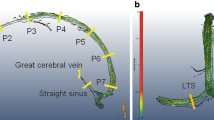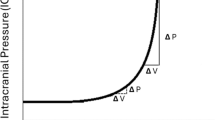Abstract
Introduction
In patients with Intracranial Hypotension Syndrome (IHS), we observed reduction of the angle between vein of the Galen (VOG) and internal cerebral vein (ICV), which returns to the baseline after treatment. We coin the term “venous hinge” to describe this dynamic process and discuss its importance in IHS.
Methods
A midsagittal T1W image showing both VOG and ICV in the same plane was reterospectively analyzed by three different neuroradiologists in 17 patients with IHS. The angle between the lines drawn along the main axis of VOG and ICV (venous hinge angle (VHA)) was measured and documented. This angle measured from the magnetic resonance imaging (MRI) of the 50 normal controls was also recorded. Paired t tests were used to compare the VHA between male and female controls and between patients of IHS and normal controls. Sensitivity, specificity, positive (PPV) and negative predictive values (NPV) were calculated. The VHA was also calculated after treatment of these patients and paired t test was done to look for significant change in the VHA after treatment.
Results
The mean VHA formed by the veins in the IHS and control groups were 65° (35–98°) and 91° (76–124°) respectively (P < 0.0001). At a VHA of 79°, the sensitivity, specificity, PPV, and NPV for diagnosis of IHS were 88.24%, 92%, 78.95%, and 95.83% respectively. In ten patients, follow-up MRI demonstrated normalization of the collapsing angle following appropriate treatment (p = 0.003).
Conclusion
We report a previously undescribed imaging finding in patients with IHS. Recognition of this sign may aid in the diagnosis of IHS.


Similar content being viewed by others
References
Mokri B, Piepgras DG, Miller GM (1997) Syndrome of Orthostatic Headaches and diffuse pachymeningeal gadolinium enhancement. Mayo Clin Proc 72:400–413
Dillon WP, Fishman RA (1998) Some lessons learned about the diagnosis and treatment of spontaneous intracranial hypotension. AJNR Am J Neuroradiol 19:1001–1002
Mokri B (2001) Syndrome of cerebral spinal fluid hypovolemia: clinical and imaging features and outcome. Neurology 56:1607–1608
Chung SJ, Kim JS, Lee MC (2000) Syndrome of cerebral spinal fluid hypovolemia: clinical and imaging features and outcome. Neurology 55:1321–1327
Chiapparini L, Farina L, D’Incerti L et al (2002) Spinal radiological findings in nine patients with spontaneous intracranial hypotension. Neuroradiology 44:143–150
Paldino M, Mogilner AY, Tenner MS (2003) Intracranial hypotension syndrome: a comprehensive review. Nerurosurg. Focus 15(6):1–8
Schievink WI (2006) Spontaneous spinal cerebrospinal fluid leaks and intracranial hypotension. JAMA 295(19):2286–2296
Schievink WI, Maya MM, Louy C et al (2008) Diagnostic criteria for spontaneous spinal CSF leaks and intracranial hypotension. AJNR Am J Neuroradiol 29:853–856
Tosaka M, Sato N, Fujimaki H, Takahashi A, Saito N (2005) Wave-like appearance of diffuse pachymeningeal enhancement associated with intracranial hypotension. Neuroradiology 47:362–367
Forghani R, Farb RI (2008) Diagnosis and temporal evolution of signs of intracranial hypotension on MRI of the brain. Neuroradiology 50:1025–1034
Farb RI, Forghani R, Lee SK et al (2007) The venous distension sign: A diagnostic sign of intracranial hypotension at MR imaging of brain. AJNR Am J Neuroradiol 28:1489–1493
Chen WT, Fuh JL, Lirng JF et al (2003) Collapsed superior ophthalmic veins in patients with spontaneous intracranial hypotension. Neurology 61:1265–1267
Headache Classification subcommittee of the International Headache Society (2004) The International Classification of Headache Disorders, 2nd ed. Cephalagia 24:1–160
Lasjaunias P, terBrugge KG, Berenstein A (2006) Intracranial venous system. In: Surgical Neuro-angiography. Volume 1, 2nd edn. Verlag Berlin Heidelberg, Springer, pp 631-713
Mckinnon SG (1998) Anatomy of the cerebral veins, dural sinuses, sella, meninges and cerebrospinal fluid spaces. In: Neuroimaging Clinics of North America 8(1):101–117
Monro A (1783) Observations on structure and functions of the nervous system. Creech and Johnson, Edinburgh, UK
Savoiardo M, Minati L, Farina L et al (2007) Spontaneous intracranial hypotension with deep brain swelling. Brain 130:1884–1893
Conflict of interest statement
We declare that we have no conflict of interest.
Author information
Authors and Affiliations
Corresponding author
Rights and permissions
About this article
Cite this article
Shankar, J.J.S., Chakraborty, S. & Lum, C. The venous hinge—an objective sign for the diagnosis and follow-up of treatment in patients with intracranial hypotension syndrome. Neuroradiology 51, 453–456 (2009). https://doi.org/10.1007/s00234-009-0518-7
Received:
Accepted:
Published:
Issue Date:
DOI: https://doi.org/10.1007/s00234-009-0518-7




